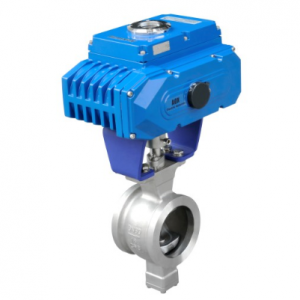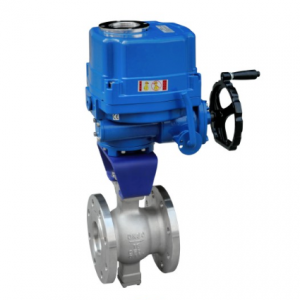一.Product Introduction
The Electric Segment Ball Valve is a sophisticated control valve that integrates a segmented ball structure with an electric actuator, designed for precise flow regulation, throttling, and on-off control in industrial applications. It combines the structural advantages of a ball valve and the precise control capabilities of an electric actuation system. This valve is widely used in industries such as petrochemical, water treatment, pharmaceutical, food processing, and power generation, where accurate control of liquids, gases, and even abrasive media is required. It is especially suitable for scenarios demanding remote, automated, and precise flow management.
二.Product Features
- Precision Flow Control: The segmented ball design enables accurate throttling and linear flow characteristic, allowing for fine adjustments to media flow rates to meet strict process control requirements.
- Electric Actuation Advantages: Equipped with an electric actuator, it supports remote control, automated operation, and precise positioning. It can be integrated into industrial control systems with signal inputs like 4-20mA, enabling real-time monitoring and adjustment.
- Robust Construction: The valve body and segmented ball are typically made from high-quality materials such as stainless steel, carbon steel, or alloys, ensuring resistance to corrosion, wear, high pressures, and temperatures for long-term reliability.
- Reliable Sealing Performance: Features advanced sealing components that provide tight shut-off with minimal leakage, complying with international leakage class standards (e.g., ANSI/FCI 70-2 Class V/VI).
- Wide Media Compatibility: Available in various material configurations, it can handle corrosive, viscous, and particulate-containing fluids, making it adaptable to diverse industrial media and operating conditions.
- Low Flow Resistance: The streamlined internal design minimizes pressure drop, promoting energy-efficient media transport and reducing operational costs.
- Easy Maintenance: Its modular structure allows for straightforward disassembly and maintenance, reducing downtime and ensuring the valve remains operational with minimal effort.
三.Technical Data
- Size Range: Typically from DN15 to DN200 (or ½” to 8”) to accommodate different pipeline specifications.
- Pressure Rating: Commonly PN10 to PN40, ANSI Class 150 to Class 300, suitable for low to medium-pressure applications.
- Temperature Range: Depending on material selection, it operates within -20℃ to 200℃ (or wider ranges with special material options for extreme conditions).
- Flow Characteristic: Linear, enabling precise flow control during throttling operations.
- Seat Leakage Class: Complies with ANSI/FCI 70-2 Class V or VI, ensuring minimal leakage.
- Material Options:
- Body: Stainless Steel (304, 316, etc.), Carbon Steel, Alloy Steel
- Ball: Stainless Steel, Hardened Alloy
- Seat: Resilient Materials (PTFE, NBR, EPDM) or Metal Seats (for high-temperature/pressure scenarios)
- Connection Type: Flanged (as shown in the image), threaded, or welded, conforming to standards like ANSI, DIN, JIS, etc.
- Electric Actuator: Features control signals such as 4-20mA, 0-10V, and supports on/off or modulating control; torque output varies with valve size and pressure rating.
- Standards Compliance: Manufactured in accordance with international standards such as API, ISO, and ASME, ensuring compatibility and reliability in global industrial applications.



